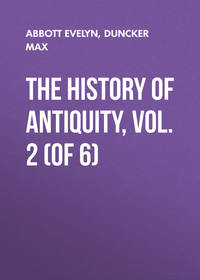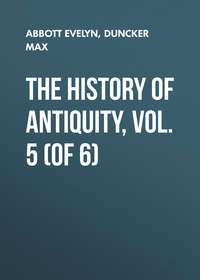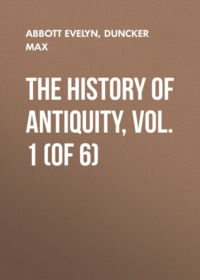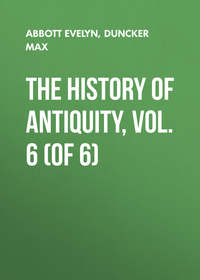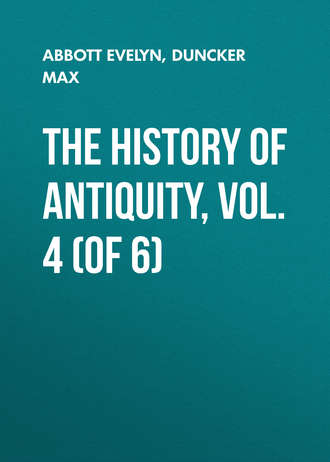 полная версия
полная версияThe History of Antiquity, Vol. 4 (of 6)
Whatever may be the case with regard to the several items of the statements of the Greeks about the worship of Dionysus and Heracles, they make it certain that in the fourth century B.C. the worship of Indra was indeed in existence, but not prominent, while the worship of Rudra-Çiva and Vishnu was in the foremost position. The worship of Vishnu was the chief worship of the Indians of the plains, i. e. of the land of the Ganges, and Krishna and Rama, the figures in the Epos, were already transformed into incarnations of Vishnu.
Of the justice of the Indians, their contempt of death, and reverence towards the kings, Ctesias has much to tell.620 The companions of Alexander extol their love of truth; no Indian was ever accused of a lie. Megasthenes adds that the Indians lent money without witnesses or seals; a man ought to know whom he could trust; if he made a mistake he must bear the loss with equanimity. Wives were generally bought of their parents for a yoke of oxen; but Megasthenes assures us that in Magadha marriages were made without giving or receiving.621 In that case the rule of the book of the law (p. 255), had become current here. The Indian wives were faithful and chaste, though it was the custom to have more than one. The Greeks also extol the moderation of the Indians in eating and drinking. The majority ate nothing but a little rice and fruits of the field; the mountaineers alone lived on the flesh of the wild animals which they caught in the chase. So little importance did they ascribe to eating that they had no fixed hour for meals. Nor did the inhabitants of the plains drink wine except at sacrifices, and this was not prepared from the grape but from rice.622 At the banquets of the rich a separate table was set apart for each guest, with a golden cup; in this first rice and then other vegetables were brought, which the Indians were very skilful in cooking.623 They were partial to singing and dancing, and paid great attention to beauty and the care of the body. They anointed themselves and had their bodies frequently rubbed; even when the king was dispensing justice four men frequently rubbed him with strigils. The hair of the Indians was plaited, and a band worn like the Persian mitre. They preferred white garments, which among them seemed brighter than with other nations, either because cotton was whiter than linen or because they appeared brighter owing to the dark colour of the Indians.624 Over the cotton shirt, reaching half way down the thigh, many threw a mantle, which was fastened under the right shoulder. Many also wore linen clothes instead of cotton, and gay garments embroidered with flowers. Their shoes were of white leather, delicate in workmanship, and provided with high parti-coloured heels, that the figure might appear taller. They allowed the beard to grow, and tended it carefully; some tribes even stained the beard with various lively hues – white, green, dark-blue, and purple-red – and the country provided excellent colours for this purpose. The richer men had rings of gold and ivory in their ears and on their hands; they had beautiful parasols held over them, and did everything that could enhance the beauty of their appearance.625 Persons of importance rode only in chariots with four horses; it was thought mean to make a journey on horseback without a retinue.626
We remember with what emphasis the hymns of the Veda inculcated honour, fidelity, truth, and the eschewal of lying; and without doubt in the ancient period the Aryas on the Indus laid as much weight on truthfulness as the Airyas of Iran. But some observations in the book of the law showed us that this virtue no longer entirely prevailed in the land of the Ganges. Buddhism earnestly reiterates the precept not to lie, and in spite of the conduct of the king of Cashmere and other princes on the Indus towards Alexander, as related to us by the Greeks, we can believe their assertions that at that time these virtues prevailed through far larger circles than at present. The moderation of the Indians in eating and drinking is due primarily, no doubt, to the climate of the Ganges; in a less degree the laws of the Brahmans respecting food, and the moderation preached by Buddha, must have operated to the same end, and above all must have tended to remove the old love of drinking among the Aryas. The love of the Aryas for dress and adornment we know from the sutras; they showed us that the richer men wore costly ear-rings of diamonds, and the poorer wore ornaments of wood or lead.627 Of Ayodhya the Ramayana boasts that no one was seen there without ear-rings and a necklace, without a chaplet on the head and perfumes.628 The dress of the women was naturally still more costly and stately. The Epos is acquainted with the custom of colouring the hands and feet with sandal or lac;629 in the later poems of the Indians we have endless praises of the jingling of the anklets, the shrill-sounding girdles, glittering with precious stones; the adornments of the neck, the eye-brows and forehead coloured with musk, antimony, and lac, the locks of hair and crowns of flowers. In all these matters the Hindus have not changed. Even now they love to wear snow-white garments, and next to these such as are of a brilliant colour; they carry gracefully the ample garment in which they wrap themselves; they dress their hair, and anoint it with palm oil, and though they no longer stain their beards blue and red, they paint on the forehead the symbol of the deity which each person specially worships. The turban, for which in some districts material interwoven with gold is preferred, is still picturesquely coiled round the head; by the different modes of wrapping may be distinguished the inhabitants of different districts. A poor man would rather give up anything than the silver ornaments of his girdle, and the poorest porter is rarely without a gold ear-ring. Weavers of garlands and silversmiths are still to be found in the most wretched villages, and any one would rather go without a dinner than without perfumes.
According to the Greeks the rites of burial were plain and simple. It was the custom of the Indians to burn the dead on pyres. As we have seen, cremation was for a long time the universal practice. It took place before the gates of the cities, where there were special places for the purpose; the corpses were wrapped in linen, and carried out on cushions amid hymns and prayers, some of the oldest of which we know (p. 62).630 The bones and anything else which remained unburnt were thrown into the water. Aristobulus says that he had heard that among some Indians the widows burned themselves voluntarily with the corpses of their husbands, and those who refused to do so were held in less estimation.631 The Greeks also observe, quite correctly, that it was not the custom among the Indians to erect mounds. In the fourth century, it is true, the followers of Buddha had erected stupas for his relics (p. 365), and possibly for those of his greatest disciples; but in any case these were so rare and so unimportant that they would hardly strike the eye; one Greek authority nevertheless asserts that there were small tumuli in India. The reason given for this omission which seemed so strange to the Greeks, is that the Indians were of opinion that the remembrance of the virtues of a man together with the hymns sung in his honour (by which can only be meant the ritual of the burial and the funeral feast) were sufficient to preserve his memory.632
The industrial skill of the Indians was not unknown to the Greeks. As early as the fifth century fine Indian clothes, silken garments called sindones or Tyrian robes, were brought by the trade of the Phenicians to Hellas. Ctesias praises the swords of Indian steel of special excellence and rare quality, which were worn at the Persian court. Other evidence also shows that the Indians at an early time understood the preparation and working of steel.633 Mining, on the other hand, according to the Greeks, they understood but ill, and their copper vessels, which were cast, not beaten, were fragile and brittle. At the sources of a river which flowed through lofty mountains into the Indus there grew, as Ctesias tells us, a kind of tree, called Siptachora, on the leaves of which lived small creatures like beetles, with long legs, and soft like caterpillars. They spoiled the fruit of the trees just as the woodlice spoiled the vines in Hellas, but from the insects when pounded came a purple colour, which gave a more beautiful and brilliant dye than the purple of the Hellenes.634 These insects of Ctesias are the beetles of the lac-tree, which suck the juice of the bark and leaves, and so provide the lac-dye. The home of this tree is the north, more especially the mountain-range on the upper Indus above Cashmere. Ctesias' statement proves that the Indians knew how to prepare the lac-dye in the fifth century B.C. The same authority mentions an ointment of the Indians, which gave the most excellent perfume; it might be perceived at a distance of four stades. This ointment, which they prepared from the resin of a kind of cedar with leaves like a palm, the Indians called Karpion. Possibly cinnamon-oil is meant, which is obtained from the outer-bark of the cinnamon tree.635
Of the military affairs of the Indians, besides what has been already quoted about the order of soldiers, the Greeks tell us that the bow was their favourite weapon. In the Veda and the Epos we found this to be the chief arm (p. 35, 89), and the good management of it was the first qualification of a hero. The Greeks tell us that the Indian bow, made of reed, was as tall as the man who carried it. In stringing it the Indians placed the lower end of the bow against the earth, and drew the string back while pressing with the left foot against the bow; their arrows were almost three cubits long. Nothing withstood these arrows; they penetrated shield and cuirass.636 Others were armed with javelins instead of the bow, and with shields of untanned ox-hide, somewhat narrower than a man but not less tall. When it came to a hand-to-hand contest, which was rarely the case among the Indians, they drew the broad-sword three cubits in length, which every one carried, and which must have been wielded with both hands. The Indians rode without a saddle; the horses were held in with bits, which took the form of a lance. To these the reins were fastened, but along with them a curb of leather, in which occasionally iron, and among the wealthier people ivory points, were placed, so as to pierce the lips of the horse when the rein was drawn.637 The Indian horsemen carried two lances and a shield smaller than that of the foot soldier. In every chariot of war besides the driver were two combatants, and on the elephants three besides the driver. On the march the chariots were drawn by oxen, and the horses led in halters, so that they came into the battle-field with vigour undiminished.638 The beating of drums and the sound of cymbals and shells, which were blown, gave the signal of attack to the army.639 The Epos exhibits to us the kings for the most part in their chariots, and in these and on the elephants it places but one combatant beside the driver. The oldest trace of the use of elephants in war is not to be found in the battle-pieces of the Epos, into which the elephants were introduced at a later time. We hear nothing of elephants in the single contests of the heroes, but it is said that in the year 529 B.C. an Indian nation put elephants in the field against Cyrus (p. 16). At a later time Ctesias is our first authority for this practice; he describes it, about the year 400 B.C., as the fixed custom of the Indians.
CHAPTER VI.
CHANDRAGUPTA OF MAGADHA
The life of the Indians had developed without interference from without, following the nature of the country and the impulse of their own dispositions. Neither Cyrus nor Darius had crossed the Indus. The arms of the Macedonians were the first to reach and subjugate the land of the Panjab. The character and manners of another nation, whose skill in war, power, and importance only made themselves felt too plainly, and to whom civilisation and success could not be denied, were not only suddenly brought into immediate proximity to the Indians, but had the most direct influence upon them.
We saw how earnestly Alexander's views were directed to the lasting maintenance of his conquests, even in the distant east. Far-seeing as were his arrangements for this purpose, strong and compact as they appeared to be, they were not able long to resist the national aversion of the Indians to foreign rule, after Alexander's untimely death. Philippus, whom he had nominated satrap of the Panjab, was attacked and slain by mutinous mercenaries, soon after Alexander's departure from India. These soldiers had been defeated by the Macedonians of Philippus, in whose place Eudemus together, with Mophis the prince of Takshaçila was charged with the temporary government of this satrapy.640 After Alexander's death (June 11, 323 B.C.), Perdiccas, the administrator of the empire, published an edict from Babylon, that "Mophis and Porus," so Diodorus tells us, "should continue to be sovereigns of these lands in the same manner as Alexander had arranged." According to Justin also the satraps already in existence were retained in India; Peithon, whom Alexander had made satrap of the lower Indus, received the command of the colonies founded there.641 In the division of the satrapies made by Antipater at Triparadeisus in the year 321 B.C., Peithon is said to have received the satrapy of upper India, while the lower region of the Indus and the city of Pattala were allotted to Porus, whose kingdom was thus largely extended. The land of Mophis, in the Vitasta, was also considerably increased. "They could not be overcome without a large army and an eminent general," says Diodorus; "it would not have been easy to remove them," Arrian tells us, "for they had considerable power."642 Porus, at any rate, was removed in another manner. Eudemus, whom Alexander had made temporary governor of the satrapy of the Panjab, must have maintained his position; he caused Porus to be murdered, and seized his elephants for himself.643
Sandrakottos, an Indian of humble origin, so Justin relates, had offended king Nandrus by his impudence,644 and the king gave orders for his execution. But his swiftness of foot saved him. Wearied with the exertion he fell asleep; a great lion approached and licked the sweat from him, and when Sandrakottos awoke the lion left him, fawning as he went. This miracle convinced Sandrakottos that he was destined for the throne. He collected a troop of robbers, called on the Indians to join him, and became the author of their liberation. When he prepared for war with the viceroy of Alexander, a wild elephant of monstrous size came up, took him on his back, and bore him on fighting bravely in the war and the battle. But the liberation which Sandrakottos obtained for the Indians was soon changed into slavery; he subjugated to his own power the nation he had set free from the dominion of strangers. At the time when Seleucus was laying the foundation of his future greatness, Sandrakottos was already in possession of India.645 Plutarch observes that Sandrakottos had seen Alexander in his early years, and afterwards used to say that the latter could have easily subdued the Prasians, i. e. the kingdom of Magadha, as the king, owing to his wickedness and low origin, was hated and despised. Not long after Sandrakottos conquered the whole of India with an army of 600,000 men.646
According to this, Sandrakottos, while still a youth, must have been in the Panjab and the land of the Indus in the years 326 and 325 B.C. when, as we have seen, Alexander marched through them. He may therefore be regarded as a native of those regions. Soon afterwards he must have entered the service of king Nandrus, who cannot be any other than the Dhanananda of Magadha, already known to us, whom the Greeks call Xandrames, and at a later time he must have escaped from his master to his own home, the land of the Indus. Here he found adherents and summoned his countrymen to their liberation. They followed him; he fought with success against the viceroys, including, no doubt, Mophis of Takshaçila, and after expelling them he gained the dominion over the whole land of the Indus. The miracles recorded by Justin point to native tradition; we have seen how readily the warriors of India compared themselves with lions. And when Sandrakottos called out his people against the Greeks, it is the beast of India, the elephant, which takes him on his back and carries him on the way to victory. Chandragupta's martial achievements and successes surpassed all that had previously taken place in India; it is sufficiently intelligible that the tradition of the Indians should represent his rapid elevation as indicated by marvels, and surround it with such.
We can fix with tolerable exactness the date at which Sandrakottos destroyed the satrapies established in the land of the Indus by Alexander. In the year 317 B.C. Eudemus is in Susiana, in the camp of Eumenes, who at that time was fighting against Antigonus for the integrity of the kingdom. The three or four thousand Macedonians, with 120 elephants, which Eudemus brings to Eumenes, appear to be the remains of the Macedonian power on the eastern bank of the Indus. Peithon, Agenor's son (p. 407), we find in the year 316 B.C. as the satrap of Antigonus in Babylon.647 Hence the power of the Greeks in the Panjab must have come to an end in the year 317 B.C. Eudemus could not have removed Porus before the year 320 B.C., for, as has been observed, Porus is mentioned in 321 as the reigning prince. Hence we may assume that in the period between 325 and 320 B.C. Sandrakottos was in the service of the king of Magadha, Dhanananda-Nandrus, that in or immediately after the year 320 he fled to the Indus, and there, possibly availing himself of the murder of Porus, summoned the Indians to fight against the Greeks, and became the sovereign of them and of Mophis by the year 317 B.C.
When master of the land of the Indus, Sandrakottos turned with the forces he had gained against the kingdom of Magadha. The weakness of the rule of Dhanananda was no doubt well known to him from personal experience; here also he was victorious. With a very large army he then proceeded to carry his conquests beyond the borders of Magadha. Justin tells us that he was in possession of the whole of India when Seleucus laid the foundations of his power. Seleucus, formerly in the troop of the 'companions' of Alexander, the son of Antiochus, founded his power when he gained Babylon, fighting with Ptolemy against Antigonus in 312 B.C., which city Peithon was unable to retain, and afterwards, in the same year, conquered the satraps of Iran. Hence in the year 315 B.C. Sandrakottos must have conquered Magadha and ascended the throne of Palibothra, since as early as 312 he could undertake further conquests, and by that time, according to Justin, had brought the whole of India, i. e. the entire land of the Ganges, under his dominion.
According to the accounts of the Buddhists, Chandragupta (Sandrakottos) sprang from the house of the Mauryas. At the time when Viradhaka, the king of the Koçalas, destroyed Kapilavastu, the home of the Enlightened (p. 363), a branch of the royal race of the Çakyas had fled to the Himalayas, and there founded a small kingdom in a mountain valley. The valley was named after the numerous peacocks (mayura) found in it; and the family who migrated there took the name of Maurya from the land. When Chandragupta's father reigned in this valley, powerful enemies invaded it; the father was killed, the mother escaped to Palibothra with her unborn child. When she had brought forth a boy there, she exposed him in the neighbourhood of a solitary fold. A bull, called Chandra (moon) from a white spot in his forehead, protected the child till the herdman found it, and gave it the name of Chandragupta, i. e. protected by the moon. The herdman reared the boy, but when no longer a child he handed him over to a hunter. While with the latter he played with the boys of the village, and held a court of justice like a king; the accused were brought forward, and one lost a hand, another a foot. Chanakya, a Brahman of Takshaçila, observed the conduct of the boy, and concluded that he was destined for great achievements. He bought Chandragupta from the herdman, discovered that he was a Maurya, and determined to make him the instrument of his revenge on king Dhanananda who had done him a great injury. In the hall of the king's palace Chanakya had once taken the seat set apart for the chief Brahman, but the king had driven him out of it. When Chandragupta had grown up, Chanakya placed him at the head of an armed troop, which he had formed by the help of money hoarded for the purpose, and raised a rebellion in Magadha. Chandragupta was defeated, and compelled to fly with Chanakya into the wilderness. Not discouraged by this failure the rebels struck out another plan. Chandragupta began a new attack from the borders, conquered one city after another, and at last Palibothra. Dhanananda was slain; and Chandragupta ascended the throne of Magadha.648
Besides the greatness of Chandragupta, the Buddhists had a special reason for glorifying the descent and origin of the founder of a dynasty which afterwards did so much to advance their creed. From this point of view it was very natural for the followers of Buddha to bring a ruler, whose grandson adopted Buddha's doctrines, into direct relation with the founder of their faith, to represent him as springing from the same family to which Buddha had belonged. Chandragupta's family was called the Mauryas; the Buddhists transformed the Çakyas into Mauryas. We shall be on much more certain ground if we adhere to Justin's statement that Chandragupta was sprung from a humble family until then unknown. The marvels with which the Buddhists surrounded his youth are easily explained from the effort to bring into prominence the lofty vocation of the founder of the dominion of the Mauryas. His mother escapes destruction. A bull protects the infant, guards the days of the child who is to be mightier than any ruler of India before him. In the game of the boys, Chandragupta shows the vocation for which he is intended. Though the Buddhist tradition puts the birth of the future king of Palibothra in that city, it allows us nevertheless to discover that Chandragupta belongs to the land of the Indus by making him the slave and instrument of a man of the Indus, Chanakya of Takshaçila. And as Justin represents Chandragupta as injuring the king of Magadha, and escaping death only by the most rapid flight, so does the tradition of the Buddhists represent him as having excited a rebellion in Magadha, the utter failure of which compels him to take refuge in flight.
In all that is essential to the story there is scarcely any contradiction between the narration of Justin and the Buddhists. We may grant to the latter that Sandrakottos, relying too much on the weakness of the throne of Magadha, raised a rebellion there, which failed of success. He flies for refuge into the land of the Indus. Successful there, and finally master of the whole, he is encouraged by his great triumphs to attack Magadha from the borders, i. e. from the land of the Indus, and now he captures one city after the other, until at length he takes Palibothra. This means that when he had become lord of the land of the Indus by the conquest of the Greeks and their vassals, he accomplishes, with the help of the forces of this region, what he had failed to carry out with his adherents in Magadha. We may certainly believe the tradition of the Buddhists that Dhanananda was slain at or after the capture of Palibothra.649
In ancient times the tribes of the Aryas had migrated from the Panjab into the valley of the Ganges; advancing by degrees they had colonised it as far as the mouth of the river. These colonists had now been conquered from their ancient home. For the first time the land of the Indus stood under one prince, for the first time the Indus and the Ganges were united into one state. After Sandrakottos had summoned the nations of the west against the Greeks, he conquered the nations of the east with their assistance. It was an empire such as no Indian king had possessed before, extending from the Indus to the mouth of the Ganges, over the whole of Aryavarta from the Himalayas to the Vindhyas. In the south-west it reached beyond the kingdom of the western Pandus to the peninsula of Guzerat, beyond the city of Automela (p. 409), and the kingdom of Ujjayini; in the south-east it went beyond Orissa to the borders of the Kalingas (p. 410). In regard to the management of this wide empire founded by Chandragupta, Megasthenes tells us that the king was surrounded by supreme counsellors, treasurers, and overseers of the army. Besides these there were numerous officers. The management of the army was carried on in divisions, which cannot surprise us after the statements of the Greeks about the strength of the army which Chandragupta maintained; Megasthenes puts it at 400,000, and Plutarch at 600,000.650 One division attended to the elephants, another to the horses, which like the former were kept in the royal stables; the third to the chariots of war. The fourth was charged with the arming of the infantry and the care of the armoury; at the end of each campaign the soldiers had to return their weapons. The fifth division undertook the supervision of the army, the baggage, the drummers, the cymbal-bearers, the oxen for drawing the provision-waggons;651 and the sixth was charged with the care of the fleet. Manu's law has mentioned to us six branches of the army, beside the four divisions of the battle array; elephants, horsemen, chariots of war, and foot soldiers, the baggage as the fifth, and the officers as the sixth member (p. 220). The land was divided into districts, which were governed by head officers and their subordinates; we remember that the book of the law advised the kings to divide their states into smaller and larger districts of ten, twenty, a hundred, or a thousand places (p. 214). Besides the officers of the districts, the judges and tax-gatherers, there were, according to Megasthenes, overseers of the mines, the woodcutters, and the tillers of the land. Other officers had the care of the rivers and the roads. These caused the highways to be made or improved, measured them, and at each ten stades, i. e. at each yodhana (1¼ mile) set up a pillar to show the distances and the direction. The great road from the Indus to Palibothra was measured by the chain; in length it was ten thousand stades, i. e. 1250 miles, a statement which will not be far wrong if this road left the Indus near the height of Takshaçila, as we may assume that it did.652 The book of the priests is acquainted with royal highways, and forbids their defilement; as we have seen, trade was vigorous in the land of the Ganges as early as the sixth century B.C.; the sutras of the Buddhists, no less than the Epos, often mention good roads extending for long distances.653 The magistrates who had care of the rivers had to provide that the canals and conduits were in good order, so that every one might have the water necessary for irrigation.


